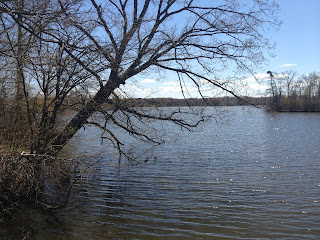But the pond had its start as a less beautiful clay pit, which provided the raw material for bricks used in over 100 buildings on the East Side and in the downtown area of Providence, and employment for generations of French-Canadian and then Italian workers.
Bricks had been made by hand from Barrington clay in the early years of the Colony. But in 1847, Nathaniel Potter of Providence conceived the idea of a commercial venture, and founded the Nayatt Brick Company on the banks of the Mouscochuck Creek and what was then a large swamp.
To harvest the clay, workers used picks and shovels to dig clay by hand from holes 12-14 feet in diameter. The clay was then carried by oxcart to the sizing machine, which formed the bricks, and then to the kilns. It took two weeks to fill the kilns, and three days to fire the bricks.
Nathaniel Potter died in 1874 (and was buried at Swan Point Cemetery in Providence). Within 20 years the company was acquired by the New England Steam Brick Company. The combined company employed 200 workers to dig out the clay: back-breaking work for the men in the pits, and more back-breaking work at home for their wives and daughters to scrub their clay-crusted clothes on washboards.
Early workers at the Nayatt Brick Company were French-Canadian. Later, in the 1880s, harsh economic conditions in Italy sent hundreds of Italian workers to work in the clay pits, and many Barrington families can trace their roots to these early workers.
By 1897, the company was producing 67 million bricks a year, three time more than any other similar operation in New England. In peak operation, in the winter, the yard would operate 24/7.
By the early 1900s there were enough Italian workers in Barrington that they wanted their own church. The brick company donated land for what became Holy Angels Catholic Church, which saw its first Mass celebrated the week before Christmas in 1913. (This was not entirely altruistic; the company's expectation was that workers would buy house lots near the Church from the company, and so they did.)
Barrington bricks were shipped all over the world--local World War II vets reported seeing Barrington bricks (with their distinctive markings) in Europe.
By the 1920s, the clay beds were 15 feet below sea level, and workers had to constantly pump water out of the pits in order to dig the clay. This became untenable within a few years, and with the clay running low, production ceased during the 1930s. The pumping was stopped, and the clay pits were allowed to flood with water. In 1940, the town of Barrington purchased the land, demolished all the remaining buildings, and began turning it into the beautiful recreational site it is today.
Illustration Credits and References
General information about the Brickyard can be found on the Barrington, RI website, in an article entitled "History of the Barrington Brickyard" by Ken Mason, on the Barrington Preservation Society and Town Museum website, and on signage along the East Bay Bike Path.
Information about Nathaniel Potter can be found at the Potter Profiles blog.
Photos by author.


